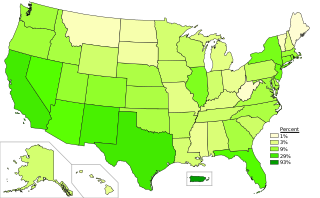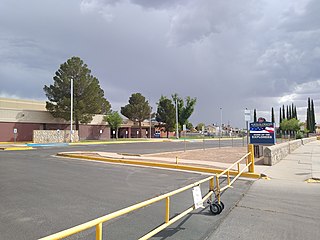
The United States does not have an official language at the federal level, but the most commonly used language is English, which is the de facto national language. It is also the language spoken at home by the great majority of the U.S. population. Many other languages are also spoken at home, especially Spanish, according to the American Community Survey (ACS) of the U.S. Census Bureau; these include indigenous languages originally spoken by Native Americans, Alaska Natives, Native Hawaiians, and native populations in the U.S. unincorporated territories. Other languages were brought in by people from Europe, Africa, Asia, other parts of the Americas, and Oceania, including multiple dialects, creole languages, pidgin languages, and sign languages originating in what is now the United States. Interlingua, an international auxiliary language, was also created in the U.S.
Language education – the process and practice of teaching a second or foreign language – is primarily a branch of applied linguistics, but can be an interdisciplinary field. There are four main learning categories for language education: communicative competencies, proficiencies, cross-cultural experiences, and multiple literacies.

Spanish is the second most spoken language in the United States. Over 42 million people aged five or older speak Spanish at home. Spanish is also the most learned language other than English, with about 8 million students. Estimates count up to 57 million native speakers, heritage language speakers, and second-language speakers. There is an Academy of the Spanish Language located in the United States as well.
A heritage language is a minority language learned by its speakers at home as children, and difficult to be fully developed because of insufficient input from the social environment. The speakers grow up with a different dominant language in which they become more competent. Polinsky and Kagan label it as a continuum that ranges from fluent speakers to barely speaking individuals of the home language. In some countries or cultures which determine a person's mother tongue by the ethnic group they belong to, a heritage language would be linked to the native language.

English as a second or foreign language is the use of English by speakers with different native languages. Language education for people learning English may be known as English as a foreign language (EFL), English as a second language (ESL), English for speakers of other languages (ESOL), English as an additional language (EAL), or English as a New Language (ENL).

Language immersion, or simply immersion, is a technique used in bilingual language education in which two languages are used for instruction in a variety of topics, including math, science, or social studies. The languages used for instruction are referred to as the L1 and the L2 for each student, with L1 being the student's native language and L2 being the second language to be acquired through immersion programs and techniques. There are different types of language immersion that depend on the age of the students, the classtime spent in L2, the subjects that are taught, and the level of participation by the speakers of L1.
A foreign language is a language that is not an official language of, nor typically spoken in, a specific country. Native speakers from that country usually need to acquire it through conscious learning, such as through language lessons at school, self-teaching, or attending language courses. A foreign language might be learned as a second language; however, there is a distinction between the two terms. A second language refers to a language that plays a significant role in the region where the speaker lives, whether for communication, education, business, or governance. Consequently, a second language is not necessarily a foreign language.
Concordia Language Villages (CLV), previously the International Language Villages, is a 501(c)(3) nonprofit organization based in Moorhead, Minnesota which operates a language and cultural immersion program, sponsored by the Concordia College. Languages are taught in summer camps, called "villages". School-year weekend programs are also offered, mostly for Spanish, French, and German. Annually, the program is attended by over 13,000 young people, aged 7–18, from every state of the US, as well as Canada and 31 other countries. It was founded in 1961.

Multilingualism is the use of more than one language, either by an individual speaker or by a group of speakers. It is believed that multilingual speakers outnumber monolingual speakers in the world's population. More than half of all Europeans claim to speak at least one language other than their mother tongue; but many read and write in one language. Multilingualism is advantageous for people wanting to participate in trade, globalization and cultural openness. Owing to the ease of access to information facilitated by the Internet, individuals' exposure to multiple languages has become increasingly possible. People who speak several languages are also called polyglots.
A modern language is any human language that is currently in use as a native language. The term is used in language education to distinguish between languages which are used for day-to-day communication and dead classical languages such as Latin and Classical Chinese, which are studied for their cultural or linguistic value. SIL Ethnologue defines a living language as "one that has at least one speaker for whom it is their first language".

The Bilingual Education Act (BEA), also known as the Title VII of the Elementary and Secondary Education Amendments of 1967, was the first United States federal legislation that recognized the needs of limited English speaking ability (LESA) students. The BEA was introduced in 1967 by Texas senator Ralph Yarborough and was both approved by the 90th United States Congress and signed by President Lyndon B. Johnson on January 2, 1968. While some states, such as California and Texas, and numerous local school districts around the country already had policies and programs designed to meet the special educational needs of elementary and secondary school students not fluent in the English language, this act signaled that the federal government now also recognized the need for and value of bilingual education programs in U.S. public education. In 1969 there was a 50% drop out rate among Mexican American students who struggled to keep up with their English-speaking peers in school; Representative Tony Abril argued that the Bilingual Education Act would reduce this number. Passed on the heels of the Civil Rights Movement, its purpose was to provide school districts with federal funds, in the form of competitive grants, to establish innovative educational programs for students with limited English speaking ability.
Less Commonly Taught Languages is a designation used in the United States for languages other than the most commonly taught foreign languages in US public schools. The term covers a wide array of world languages, ranging from some of the world's largest and most influential, and holds international recognization such as Chinese, Russian, Arabic, Bengali, Hindi, Portuguese, Japanese, Persian, Urdu, Turkish, Swahili, Italian, and Tamil to smaller regional languages studied in the US mainly by area experts, such as Twi, spoken in West Africa, and Finnish.
Dual language is a form of education in which students are taught literacy and content in two languages. Most dual language programs in the United States teach in English and Spanish, but programs increasingly use a partner language other than Spanish, such as Arabic, Chinese, French, Hawaiian, Japanese, or Korean. Dual language programs use the partner language for at least half of the instructional day in the elementary years.

Alicia R. Chacón International School is a K–8 school in El Paso, Texas. It is operated by the Ysleta Independent School District.
Heritage language learning, or heritage language acquisition, is the act of learning a heritage language from an ethnolinguistic group that traditionally speaks the language, or from those whose family historically spoke the language. According to a commonly accepted definition by Valdés, heritage languages are generally minority languages in society and are typically learned at home during childhood. When a heritage language learner grows up in an environment with a dominant language that is different from their heritage language, the learner appears to be more competent in the dominant language and often feels more comfortable speaking in that language. "Heritage language" may also be referred to as "community language", "home language", and "ancestral language".
Practices in language education vary significantly by region. Firstly, the languages being learned differ; in the United States, Spanish is the most popular language to be learned, whereas the most popular languages to be learned in Australia are German, French, Italian and Mandarin Chinese. Also, teaching methods tend to differ by region. Language immersion is popular in some European countries, and not used very much in the United States.
Utah's dual language immersion program was created in 2008 to help students achieve proficiency in a second language in preparation for future careers and the global economy. In the early school years, the students are immersed for half a day in a target language – Mandarin Chinese, French, Spanish, Portuguese, or German – and half a day in English. In high school, students can participate in a bridge program, allowing them to take language classes that would give them concurrent college credit at certain universities throughout Utah. Over 160 schools in Utah participate in the program. Proven benefits include an increased performance on standardized tests, fluency in a target language, and an increased cultural awareness and sensitivity.
Students who are learning English in their home country, typically in a school, are EFL students. More generally, students learning English are referred to as ELLs.
The following is a list of bilingual education by country or region.






